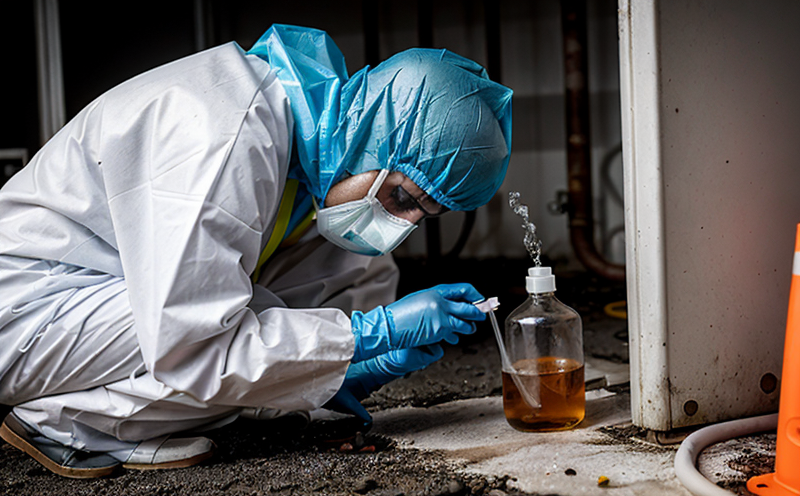ISO 4491 Oxygen Content Testing in Sintered Metal Powders
The testing of oxygen content in sintered metal powders is essential to ensure product quality, safety, and compliance with international standards. This critical procedure, governed by ISO 4491, helps manufacturers verify that the oxygen levels are within acceptable limits for specific applications.
Sintering is a process used to produce solid materials from powder grains through heat and pressure without melting them completely. The resulting material retains its structural integrity and properties as a result of grain boundary diffusion processes. Oxygen content in sintered metal powders can significantly impact the mechanical, physical, and chemical performance of the final product.
Accurate oxygen content analysis is particularly important for industries such as aerospace, automotive, and medical devices where material purity and consistency are paramount. This test ensures that the sintering process does not inadvertently introduce unwanted elements into the metal powder, which could compromise the integrity and safety of the end-product.
The ISO 4491 standard provides a precise method for determining the oxygen content in sintered metal powders by combustion analysis. The procedure involves heating a precisely weighed sample to a temperature that allows the release of oxygen from the powder, followed by measuring the resulting increase in mass as the oxygen is consumed.
This process not only ensures product quality but also aligns with regulatory requirements for material purity and safety. For instance, excessive oxygen content can lead to increased oxidation during sintering, which may cause undesirable changes in the microstructure of the final product. Conversely, insufficient oxygen content might indicate incomplete combustion or contamination.
The accuracy of this test is crucial as even small variations in oxygen levels can have significant effects on the mechanical properties and performance of the sintered metal parts. For example, higher oxygen contents may lead to lower strength and ductility, while lower contents could result in increased brittleness.
Our laboratory adheres strictly to ISO 4491 procedures to ensure reliable results. We use state-of-the-art equipment and highly skilled personnel to carry out this testing accurately. The precision of our measurements is further enhanced by using high-quality reference materials and rigorous quality control measures.
The importance of oxygen content testing extends beyond mere compliance; it plays a critical role in optimizing production processes, ensuring product consistency, and enhancing overall performance. By maintaining consistent oxygen levels, manufacturers can achieve better control over the sintering process, leading to higher quality products that meet stringent industry standards.
Our service also supports research and development efforts by providing detailed insights into how variations in oxygen content affect different materials and their intended applications. This information is invaluable for innovators looking to push the boundaries of what is possible with metal powder sintering technology.
Scope and Methodology
| Aspect | Description |
|---|---|
| Sample Preparation | The sample must be accurately weighed before being placed into the combustion chamber. |
| Combustion Temperature | The temperature should be controlled to ensure complete release of oxygen from the powder. |
| Oxygen Consumption Measurement | This involves precise measurement of the mass increase as oxygen is consumed during combustion. |
| Data Analysis | Results are analyzed using statistical methods to provide accurate readings. |
The ISO 4491 standard specifies detailed procedures for each step of this process, from sample preparation to final data analysis. Adhering strictly to these guidelines ensures that the results are both reliable and reproducible.
Our laboratory employs advanced combustion analyzers capable of providing highly accurate measurements of oxygen content. These instruments are calibrated regularly against certified reference materials to ensure their precision and accuracy. Additionally, we maintain strict quality control measures throughout the testing process to minimize any potential sources of error.
Competitive Advantage and Market Impact
Accurate oxygen content testing is becoming increasingly important as industries demand higher standards of product quality and safety. By offering this service, our laboratory provides a critical tool for manufacturers looking to stay ahead in the competitive global market.
Our adherence to ISO 4491 ensures that we deliver results that are not only compliant with international regulations but also provide valuable insights into material performance. This level of detail can be used by companies to make informed decisions about their production processes, ultimately leading to improved product quality and reduced costs associated with rework or scrap.
In an era where supply chain transparency is key, our testing services help build trust between suppliers and customers. By ensuring consistent oxygen content across batches, we contribute to the reliability of materials used in critical applications such as aerospace engines and medical implants.
The ability to consistently meet stringent quality standards also enhances a company's reputation within its industry. This can lead to increased market share and better relationships with clients who value reliability and safety above all else.
Use Cases and Application Examples
| Industry | Application |
|---|---|
| Aerospace | Verifying oxygen content in metal powders used for engine components. |
| Automotive | Ensuring the purity of metals in exhaust systems to meet emissions standards. |
| Medical Devices | Guaranteeing the quality of materials used in implants and surgical instruments. |
| Defense | Testing oxygen content in critical components for defense applications. |
In each case, accurate oxygen content testing is vital to ensure that the final product meets the required specifications. For example, in the aerospace industry, any deviation from standard oxygen levels could lead to performance issues or even safety hazards during flight.
The automotive sector also relies heavily on this test when it comes to exhaust systems. Ensuring the correct amount of oxygen helps reduce emissions while maintaining engine efficiency. In medical devices, purity is crucial for ensuring that implants and instruments do not introduce contaminants into patients' bodies.
Similarly, in defense applications, precise control over materials used ensures reliability under extreme conditions. Whether it's a jet engine or a soldier's gear, the integrity of the materials used directly impacts performance and safety.





